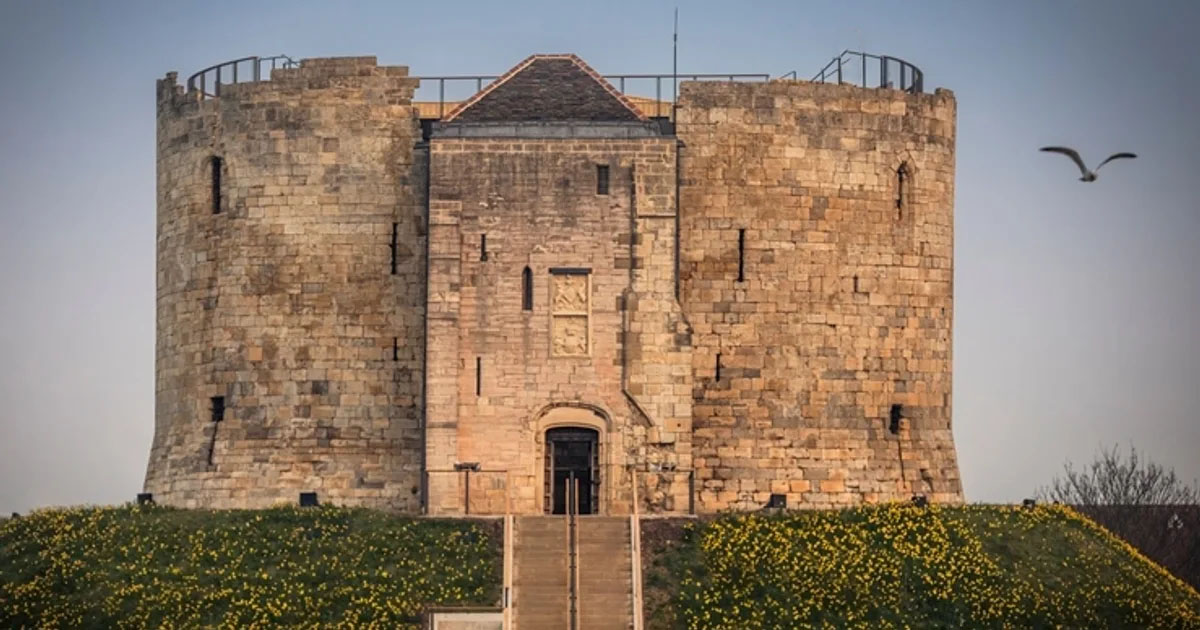York Castle
York Castle stands as a significant landmark in the historic city of York, England. Known for its rich history, it has an architectural evolution that has played a crucial role in England’s medieval and modern history. The site has witnessed battles, political intrigue, and social transformation over the centuries. Much of the original structure has changed. Over time, they lost some of it, but the remaining elements, including Clifford’s Tower, still provide a glimpse into the past. They offer visitors a unique opportunity to explore the layers of history embedded in the castle grounds.
Can’t wait to visit York and the Clifford’s Tower? Book your tour online.
Location of York Castle
York Castle is located in the heart of York, a city renowned for its historical significance in northern England. Moreover, the castle is strategically positioned on a hill overlooking the River Foss. The river provided natural defense and contributed to its importance as a military stronghold. Additionally, the central location within York allows easy access for visitors. This has made it a focal point in the city’s historical narrative. The castle is surrounded by modern developments, yet it retains a distinct presence. This presence bridges the gap between York’s ancient past and its contemporary identity.

History of York Castle
The history of York Castle dates back to the Norman Conquest of England in 1066. Following William the Conqueror’s victory at the Battle of Hastings, York became a crucial center of power in the north. To secure his control, William ordered the construction of a motte-and-bailey castle on the site in 1068. This early fortification was a wooden structure. It served as a symbol of Norman authority and a defensive position against rebellious forces.
In the following centuries, York Castle underwent significant transformations. Stone fortifications, including Clifford’s Tower, replaced the wooden castle in the 13th century. They named Clifford’s Tower after Roger de Clifford, who was executed there in 1322. It became the central keep of the castle and has remained one of its most iconic features. Builders constructed the tower on the original motte. They designed it to serve as both a defensive structure and a residence for the royal garrison stationed in York.
Throughout the medieval period, York Castle was frequently used as a royal residence and administrative center. It played a prominent role in various conflicts, including the Wars of the Roses in the 15th century. During that time, it served as a base for both Lancastrian and Yorkist forces. The castle’s strategic importance diminished over time, particularly after the union of the English and Scottish crowns in the early 17th century. By the 18th century, much of the castle had fallen into disrepair.
However, they did not abandon York Castle entirely. Instead, they repurposed the site for various uses, including as a prison and law court. The most notable development during this period was the construction of the York Crown Court and the Debtors’ Prison in the 18th century. Both of these structures remain standing today.

Current status
Today, York Castle is a popular tourist attraction and an essential part of York’s cultural heritage. Although they lost much of the original structure, the remnants of the castle, including Clifford’s Tower, continue to draw visitors from around the world. English Heritage manages Clifford’s Tower. It offers panoramic views of York and provides insight into the medieval history of the city. The tower’s interior has been partially restored, allowing visitors to explore its chambers. They can learn about its historical significance through various exhibits and informational displays.
They have transformed the castle grounds into public spaces, integrating the site into the broader urban landscape of York. The York Castle Museum is located in the former Debtors’ Prison. It is another major attraction on the site. The museum offers a comprehensive look at York’s social history. It has exhibits ranging from Victorian-era streets to the history of crime and punishment in the region. This blending of historical preservation and modern adaptation ensures that York Castle remains relevant and accessible to contemporary audiences.
In addition to its historical and cultural significance, York Castle continues to be a focal point for events and activities in the city. The castle grounds regularly host seasonal events, reenactments, and educational programs. These activities further enhance its role as a living monument to York’s past. The site is also an important subject of ongoing archaeological research. They are making efforts to uncover and preserve more of its historical layers.
Admission
Community features
Castle features
Video
Location
Official website
Featured listings














